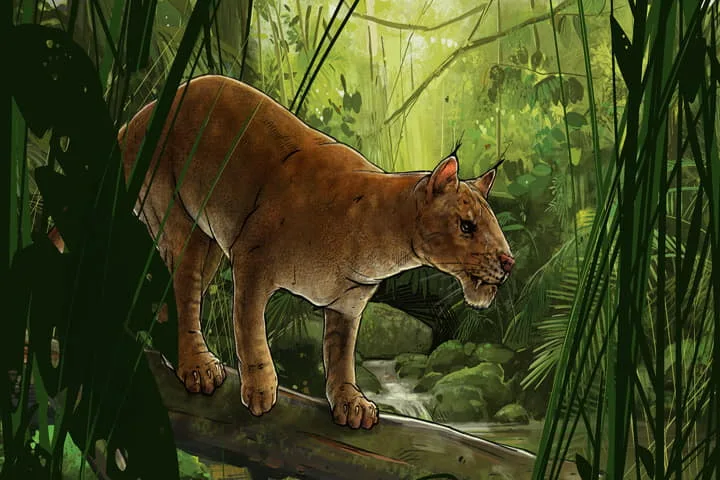

An illustration showing the bobcat-sized species with an appetite for almost only meat which roamed in today's San Diego some 42 million years ago (Pic. Courtesy sciencenews.org)
<p>
<strong>Right from the inception of life on the Earth, some or the other mighty predator dominated the world, it could be a mighty shark in water or a dinosaur on the land. Likewise, a report in sciencenews,.org talks about a sabre-toothed mammal which was among the first hypercarnivores, that existed 42 million years.</strong></p>
<p>
This menacing creature whose size was that of a bobcat, stalked in the jungles and forests of those days located in today&rsquo;s San Diego. As compared to the other animals that existed in that era, this was a hypercarnivore &ndash; it evolved to consume meat and probably only meat.</p>
<p>
What was distinctive about this creature or Diegoaelurus vanvalkenburghae as it is scientifically known, and which belonged to the now vanished and unusual Machaeroidine family, is its fangs which were sabre-like and its sharp and slicing teeth.</p>
<p>
Till now a dozen fossils or remains of other Machaeroidine have been discovered, which mostly are from Wyoming but some were found in Asia too. It was with the help of a 71-millimetre-long lower jawbone that the scientists identified this new predator. This jawbone with teeth was found in a fossil bed in San Diego County.</p>
<p>
<strong>Also read: <a href="https://www.indianarrative.com/science-news/named-after-a-rose-a-colourful-fish-from-the-maldives-is-the-pride-of-natives-157432.html">Named after a rose, a colourful fish from the Maldives is the pride of natives</a></strong></p>
<p>
What the fossil suggested is that the animal had sabre-like canine teeth which were long since its bony chin was downturned. This helped in protecting those long-pointed teeth while a gap was there in the lower teeth to fit them, remarked Ashley Poust.</p>
<p>
Poust is a palaeontologist at the San Diego Natural History Museum.</p>
<p>
During the discovery, the canines of the creature were not recovered.</p>
<p>
The details of this newly found predator was published in PeerJ, a peer reviewed journal.</p>
<p>
Sharing details about creature Poust said: <a href="https://www.sciencenews.org/article/saber-toothed-mammal-hypercarnivore-fossil?utm_source=email&amp;utm_medium=email&amp;utm_campaign=latest-newsletter-v2&amp;utm_source=Latest_Headlines&amp;utm_medium=email&amp;utm_campaign=Latest_Headlines">&ldquo;Those big fangs were either used</a> to bite into the throat of the prey or were used to rip and tear the flesh. This fossil, in particular, helps us understand what the whole food web would&rsquo;ve looked like.&hellip; Now we know that there might have been this crazy sabre-toothed animal stalking primates in the branches or maybe stalking the tapirs in the leaves below.&rdquo;</p>
<p>
This freshly found D. vanvalkenburghae fossils gives us glimpse into the life of these early predators who came up independently and evolved the ability to cut through flesh with adroitness. These fangs have been seen in several other animals from the ancient times ranging from anchovies to recently discovered sabre-toothed cats like Smilodon. All of them made an appearance on the Earth several million years after the D. vanvalkenburghae had become extinct.</p>
Highlighting the use of indigenous platforms during Operation Sindoor, Chief of Defence Staff (CDS) General…
Congress MP Shashi Tharoor on Friday (local time) said that Colombia will issue a statement…
Minister for Electronics and Information Technology Ashwini Vaishnaw said on Friday that the government is…
Renowned human rights activist and political analyst Amjad Ayub Mirza has expressed a strong denunciation…
As was widely expected, the Indian economy grew by 6.5 per cent in real terms…
World No Tobacco Day, marked annually on 31 May, addresses a major public health challenge--the…